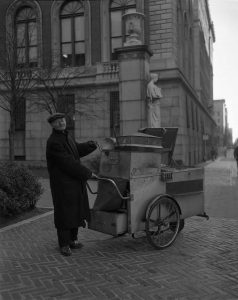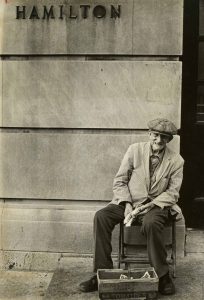Local neighborhood vendors, located both on campus and just off campus, have been a part of a Columbian’s daily life since the move to Morningside Heights in 1897. Two vendors in particular had lengthy relationships with those on campus and were fondly remembered by those who interacted with them.
Greek immigrant John Courtsounis or, as he was known, “Peanut John” sold roasted peanuts from a cart parked just outside the gates at the corner of 116th Street and Broadway, from
1908 until his death in March 1959. At first he worked from a wooden pushcart with a sign advertising “5c.-HOT ROASTED Virginia PEANUTS-5c.”. Then, in

1948, he and his partner Pete Moustakas bought a 6 x 13 chromium plated motorized trailer from which they hawked their peanuts. He was a beloved fixture on campus. Columbia President Nicholas Murray Butler invited him to tea at Faculty House and even provided him with a letter telling the police that he had a perfect right to park his peanut stand on the northeast corner of Broadway and 116th Street. Even short-term Columbia President Dwight D. Eisenhower was said to partake of his peanuts. In December 1954, as part of Columbia’s Bicentennial celebrations, he was honored with 25 other local merchants in a special Bicentennial convocation. They received a special Bicentennial medal and certificate of esteem from President Grayson Kirk for their contributions to the neighborhood making ”Morningside a friendly place in which to live.” Mr. Courtsounis was cited by Columbia in the following words: “A specialist in peanuts and roasted chestnuts, he proudly characterizes himself as an American businessman.”

Sam Steinberg, a native of The Bronx, was another campus fixture for about 40 years. Beginning in 1937 until he died in 1982, he was a candy vendor and, later, an artist who wore a taxi driver cap and commuted daily from the Bronx to sell his wares on campus. In his later years, he was routinely found outside the former student center Ferris Booth Hall and was popularly regarded as Columbia’s unofficial artist-in-residence. Sam’s paintings—heavy black lines on cardboard, colored with bright felt-tipped pens—were a later addition to his candy sales. In October of 1978 more than 50 of Sam’s works were exhibited in Ferris Booth Hall under the sponsorship of the Student Modern Art League. The show included candy bars for the patrons. He was well-loved for his unique personality, his “Hoishey” bars, and his penned birds and snakes. He was so well known on campus that JESTER artist Charles Saxon (later a cartoonist for The New Yorker) created a caricature of Sam that was published in the June 1940 issue of the campus humor magazine. Sam is still remembered quite fondly by the students and staff who knew him. When he passed away, Spectator interviewed several individuals and Roger Lehecka, College dean of students at the time was quoted as saying: “It’s terrible news for all of us. It’s not going to be the same here without him.”